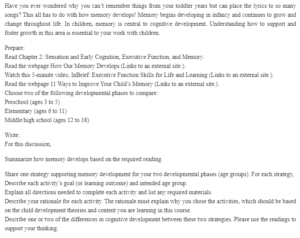Memory Development
The process of memory development is a lifelong course that lasts through adulthood. So, how does memory develop? As an individual processes events, brain neurons pass information via synapses (tiny gaps between neurons) (Goldberg, 2022). These synapses then welcome adjacent neurons to begin firing, forming a network of contacts of different strengths. Therefore, memory is a persistent variation in the pattern and strength of contacts’ connections. The chosen group for comparison is preschool (ages 3-5) and elementary school (ages 6-11). The memory and cognitive development of a pre-schooler are low.
Do you need an original copy of “Memory Development” ? Contact us.
Additionally, their brain is more of an executive function like an airline, and they can only memorize a few things like names and numbers. On the contrary, their memory and brain are almost fully developed in the elementary school group, and they can understand right or wrong (Romero et al., 2018). They can memorize so much when educators implement the right strategies.
Therefore, the most appropriate strategy that can support memory development for pre-schoolers is creating rhymes and songs, and for elementary school is using visual aids (Oxford Learning, 2017). Rhymes and songs are practical for preschools because their primary goal is cognitive development. Notably, rhymes and songs teach how language works and help build learners’ memory abilities. Educators can teach rhymes and songs in class using books, charts, audio music, and songs. In addition, the teacher begins this activity by introducing it to the learners. The rationale of this strategy is to help children improve their memory and recall because human brains are reinforced to identify patterns and songs; thus, singing poems and music would be effective for pre-schoolers.
Visual aids would be the most appropriate strategy for elementary scholars because their primary goal is to improve memory by helping learners remember recently heard or read information. Educators can use visual aids to teach all subjects by creating flashcards with images or words to match exercises or practice word definitions. Some of the materials to implement this strategy are charts, flashcards, and videos. The rationale for using visual aids is learners can easily refer to them to recall whatever they learned in the past and retain it for a more extended period.
The cognitive difference between the two selected strategies is that songs and rhymes promote cognitive functions that help introduce learners to learning language and reading. Such happens because the brain at this stage performs minimal memorization due to children’s self-centred nature. The video demonstrates children arranging patterns as taught by the teacher (Center on the Developing Child at Harvard University, 2022). However, elementary students’ brains are almost fully developed, and the neurons can facilitate higher levels of cognitive function, such as logical reasoning, conceptual tasks, and complex problem-solving. At this stage, learners start changing their thoughts about the world. This is entirely different from the selfish thinking of pre-schoolers as elementary learners start developing more mature and divergent ways of understanding.
References
Centre on the Developing Child at Harvard University. (2022). Video Executive Function: Skills for Life and Learning. Retrieved 2 September 2022, from https://developingchild.harvard.edu/resources/inbrief-executive-function-skills-for-life-and-learning/.
Goldberg, C. (2022). How our memory develops. Curious. Retrieved 2 September 2022, from https://www.science.org.au/curious/people-medicine/how-memory-develops#:~:text=As%20a%20person%20processes%20an,that%20is%20a%20′ memory.
Oxford Learning. (2017). 11 Ways to Improve Your Child’s Memory Power. Retrieved 2 September 2022, from https://www.oxfordlearning.com/11-ways-to-improve-memory-for-kids/.
Romero-Ayuso, D., Jorquera-Cabrera, S., Segura-Fragoso, A., Toledano-González, A., Rodríguez-Martínez, M. C., & Triviño-Juárez, J. M. (2018). Assessment of childhood sensory processing and executive functions: development, reliability, and validity of the EPYFEI. Frontiers in pediatrics, 6, 71.
ORDER A PLAGIARISM-FREE PAPER HERE
We’ll write everything from scratch
Question 
Have you ever wondered why you can’t remember things from your toddler years but can place the lyrics to so many songs? This all has to do with how memory develops! Memory begins developing in infancy and continues to grow and change throughout life. In children, memory is central to cognitive development. Understanding how to support and foster growth in this area is essential to your work with children.

Memory Development
Prepare:
Read Chapter 2: Sensation and Early Cognition, Executive Function, and Memory.
Read the webpage How Our Memory Develops (Links to an external site.).
Watch this 5-minute video, InBrief: Executive Function Skills for Life and Learning (Links to an external site.).
Read the webpage 11 Ways to Improve Your Child’s Memory (Links to an external site.).
Choose two of the following developmental phases to compare:
Preschool (ages 3 to 5)
Elementary (ages 6 to 11)
Middle/high school (ages 12 to 18)
Write:
For this discussion,
Summarize how memory develops based on the required reading.
Share one strategy supporting memory development for your two developmental phases (age groups). For each strategy,
Describe each activity’s goal (or learning outcome) and intended age group.
Explain all directions needed to complete each activity and list any required materials.
Describe your rationale for each activity. The rationale must explain why you chose the activities, which should be based on the child development theories and content you are learning in this course.
Describe one or two of the differences in cognitive development between these two strategies. Please use the readings to support your thinking.
